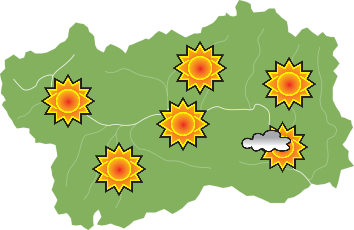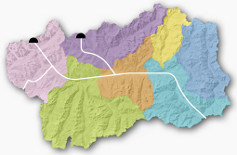The upper Lys Valley: from Issime to Gressoney-La-Trinité. In the land of the Walser people
How: by car.
Recommended duration: one day.
Recommended period: all year round.
Distance: around 28 km.
A journey to discover the land of the Walser people originating from Swiss Valais.
The Walser colonised this territory during the 13th century coming from Zermatt from the beginning of the 13th century and settling over almost all of the Lys Valley (Gressoney, Issime, Gaby and Niel) and the upper Ayas Valley (Canton des Allemands), through the Theodule pass (3317 m) to the West, and from Monte Moro (2984 m) to the East.
These migrations occurred due to reasons associated with economic and demographic factors, such as the economic hardship and the excessive population of the territories of origin, but above all in the will of the feudal lords of Valais who saw in them the opportunity to exploit and make money from the properties beyond the Alps.
An important distinctive element of the Walser culture is the language töitschu, which is the dialect spoken in the Issime area, and titsch, typical of the Gressoney area, very similar to the German idiom both for vocabulary and the speech structure. Their distribution and d stabilisation has certainly been favoured by the continuous trade and cultural relationships with the countries of origin.
In 1970, the coat of arms of the Walser community was introduced (a red and white heart with 10 stars) which symbolically contains the whole history of the Walser people. A special valley, where a strong cultural identity melts with an authentic and fascinating landscape.
Once left Fontainemore, going up the valley, you will meet the town of Issime ( Eischeme ), where it is worth stopping to visit the Parish Church of San Giacomo, a building of considerable historic and artistic interest. Historical sources attest that it definitely existed in the 12th century, however it was completely rebuilt at the end of the 17th century. A beautiful fresco covers the entire facade with a representation of the Last Judgment. The Mauritius cross and the carved wooden door are particularly prestigious; inside the Church there is a noteworthy High Altar built in the baroque style at the beginning of 18th century and decorated by 182 statues. Up until the 18th century, the municipality was run by 3 mayors chosen from among the heads of the most distinguished families, one for the lower plain (the current provincial capital and valley floor), another for the mountain of the valleys of San Grato and Burinni and, finally, a third for the upper plain, now the territory of Gaby. The last significant event of certain relevance for the life of the town was the division from Gaby in 1952.
Coming then to Gaby, a particular French-Provence island between the Walser settlements of Issime and Gressoney, nestled in a grassy valley floor surrounded by steep mountain slopes. Typical in this area is the presence of the ‘Rascards’, wooden structures which are often to be found alongside other types built completely out of stone, such as the admired fortified houses.
Halfway between Issime and Gaby there is the Vourry Sanctuary, dedicated to Our Lady of Grace, particularly beautiful due to the Way of the Cross placed above the Sanctuary to imitate the Calvary at Varallo Sesia.
Also noteworthy in this town are the beautiful presbytery frescos of the Parish Church dedicated to Saint Michael, rebuilt at the beginning of the 1800s in the site of the ancient chapel of Saint-Michel de Chamboursière (today Kiamourseyra).
From Gaby, the journey continues to Gressoney-Saint-Jean ( Onderteil ), the largest and most populated centre of the valley, the history of which is closely linked to that of the Walser community, whose culture, traditions, original architecture and language are still alive today. The parish church, dedicated to John the Baptist was erected in 1515 and subsequently expanded in 1753, the year in which the imposing stone cross that dominates the space in front of the building, once used as a cemetery, was positioned. The 17th century portico includes a series of chapels (d’Gheimnisse) decorated with paintings dedicated to the ‘Mysteries of the Way of the Cross’.
Noteworthy are also the chapels of the village of Ecko, which dates back to 1657, and of the village of Chaschtal, built in 1717 upon the ruins of a fortress belonging to the Counts of Challant.
Not to be missed is the splendid Savoy Castle, the fabulous profile of which is glimpsed in the midst of a pine forest just south of the town, at Belvedere. The castle was built between 1899 and 1904 upon the desire of Queen Margaret of Savoy, who stayed there during the summer months until 1925; the building is evocative of a medieval manor made up of a central nucleus sided by 5 pointed towers, each one different from the other, and is structured over 3 floors: the ground floor with living quarters, the main floor with the royal apartments and the second floor reserved for gentlemen of the court. The refined internal décor, reminiscent of the Art Nouveau style, are a tribute to the Queen, remembered by floors and initials, whereas the coffered ceilings, the wooden panels and the furnishings are of medieval inspiration. The dependence, known as Romitaggio Carducci, is found not too far away, dedicated to the memory of the poet who was a guest and devoted bard of the Queen. Finally, at the foot of the castle, there is a rocky garden full of plant species typical of the local alpine flora (the best period for admiring the blooms are the months from July to September/October). The Savoy Castle is open and can be visited all year round.
Another notable building is Villa Margherita, constructed in 1883 by Baron Luigi Beck Peccoz to host Queen Margaret of Savoy from 1889 to 1904. Villa Margherita was purchased by the Municipality of Gressoney-Saint-Jean in 1968 and is intended to be the Town Hall.
Groups interested in getting to know more about the origins and traditions of the Walser people can contact the Walser Cultural Centre (tel./fax +39 (0) 125 356248 – walserkultur@libero.it ).
The Alpenfaunamuseum – Regional museum of alpine fauna – hosts a rare and rich collection of hunting trophies, antique weapons, paintings, books and publications regarding alpine fauna. Inside the Museum, exhibitions of artists and/or craftsmen from the Aosta Valley are regularly organised.
The final step of the journey then leads to Gressoney-La-Trinité ( Oberteil ), an alpine resort with an established reputation and a departure point for ascending to the Monte Rosa range and well-equipped for winter sports.
Numerous and picturesque are the Walser buildings of the valley, scattered throughout the area in accordance with the German custom and which are distinguishable in their structure from the ‘rascards’, primitive dwellings built from wood which are largely widespread in the Aosta Valley.
Since its construction, the church received the name of the ‘Holy Trinity’; as a parish church it was given Saint Francesco Saverio as patron, since it was not possible to attribute the patron title to the Holy Trinity. It was consecrated by Mons. Milliet d’Arvillars on 24th June 1702. The entrance opens into the old cemetery, today declared a monumental area and no longer intended for funerals. The bell tower, square with single lancet windows and an onion spire, stands about thirty metres high, and had 3 bells in 1702. One bell, called Ulrich, was cast in Asti in 1855, after several attempts made on the site. Three other bells were added in 1933. The entire bell tower, crumbling, was renovated and completed; it was inaugurated and blessed by Bishop Lari of Aosta, on 20th September 1992. With its twelve bells, it is now the most complete bell tower in Piedmont and the Aosta Valley. The oldest bell is safely secured in the court yard, cast in La Trinité and blessed on 9th September 1789.
Among the numerous chapels in the area, that of the town of Stafal-Oagre is worth of a note, built in 1776 by G. J. Curtaz of Gressonay, parish priest at Issime, in memory of his mother Caterina Knobal and the vision that she had on lst February 1701 at the fountain which existed on the site. The chapel, dedicated to Our Lady of the Snow, has become a centre of Marian devotion for Gressoney, a pilgrimage destination (5th August).
Finally, the characteristic chapel structured ‘in transit’ is located in the Underwoald region, near the provincial capital: it is known as the ‘Chapel of the dead’ (Tototschappolo) and its only function is still today of welcoming funeral processions from the hamlets.
At Gressoney-La-Trinité, the Eco-museum offers visits to 3 structures to discover the Walser people:
- The Rural House – Puròhus: an old rural house from 1700 which offers the authentic atmosphere of a typical Walser dwelling with its ‘wohngade’, barn house. The enchanting vaulted cellar and the barn which houses the work tools.
- The Museum house – Pòtzsch hus: permanent exhibitions dedicated to the territory are displayed in the rooms of this ‘stadel’, a typical Walser home.
- The Mountain hut of Binò Alpelté: this is a small mountain pasture (Alpelté) in the town of Binò, with the interesting peculiarity of being built in the shelter of a single rock mass (balma) which serves as a roof.












